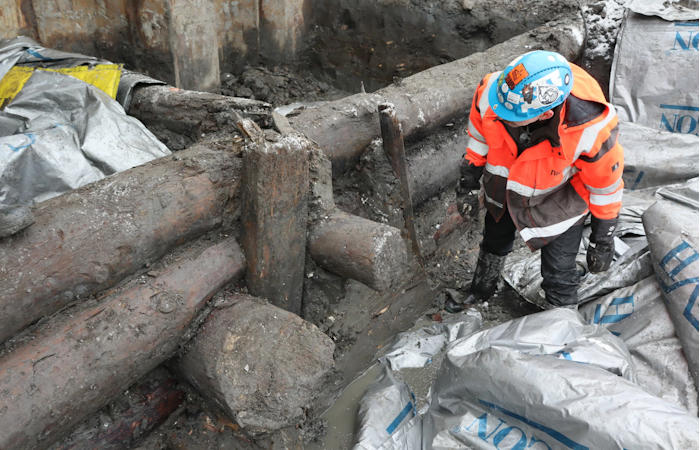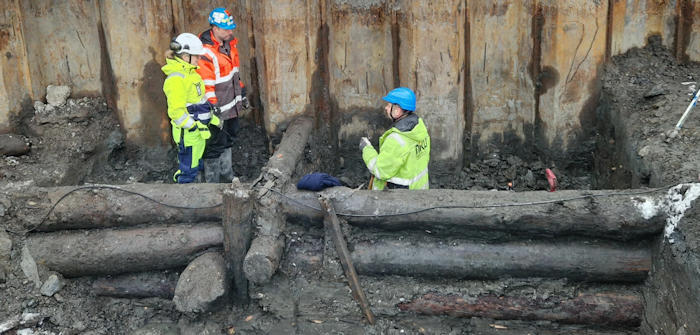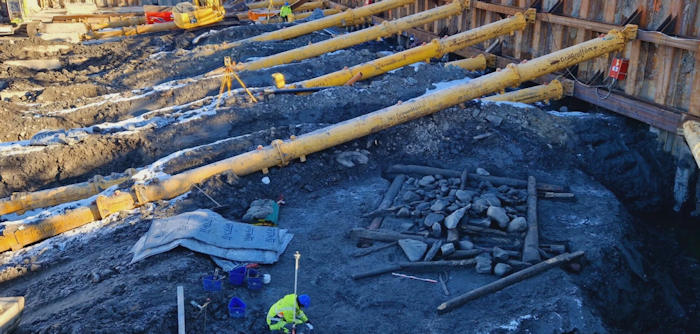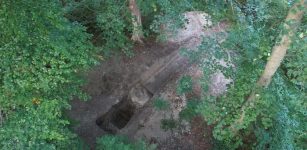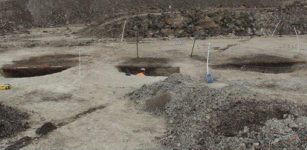Why Did Archaeologists Destroy Medieval King’s Wharf After Excavations?
Jan Bartek - AncientPages.com - While excavating at Bjørvika, east of Oslo’s center in Norway, scientists discovered the remains of an ancient structure. It turned out that these remains were a massive foundation for a wharf. It might have been the King's Wharf during medieval times. Unfortunately, soon after the wharf was found, it was gone again.
These logs are larger than scientists have ever found before, according to project manager and archaeologist Håvard Hegdal. (Photo: Sara Langvik Berge / NIKU)
Håvard Hegdal, an archaeologist from the Norwegian Institute for Cultural Heritage Research (NIKU) is the project manager for one of the last excavations in Bjørvika, an area in what was once a very central part of medieval Oslo — the harbor. While describing the impressive find, he also adds the size of the timber is extraordinary.
"Now we have arrived at the most interesting area in our entire excavation and the find that we have been most looking forward to,” says Hegdal in a video about the find.
“And that's what’s been called the King’s Wharf. It’s completely crazy. The dimensions of the timber here are insane. The logs are twice as thick as any we have found before,” he says.
"The first parts of the wharf were found during excavations in the 1990s. Core samples from before the current excavation indicated that it would be possible to find a small remnant of the foundation from the wharf even now.
Saving such huge logs would require much place and money. (Photo: Sara Langvik Berge / NIKU)
The wharf lies in a straight line from the fjord to what was the King’s Estate in Oslo in the 12th and 13th centuries. This is partly why the archaeologists think it may be the King's Wharf.
The wharf was also far below a clear layer of blue clay which originates from a landslide that started in the nearby Alna River. This landslide is dated to the end of the 14th century or the beginning of the 15th century, which means the wharf must have been built long before that.
Medieval Oslo at this time had several wharves that provided water access. Several of the roads down to the sea, one called Klemensallmenningen and another called Bispeallmenningen — ended in wharves.
Boats from all over the world entered the harbor city of Oslo right here. They were greeted by the bustle of life on the wharves, which were covered with merchant stalls, warehouses, meeting places and inns.
More than 40 boats dating from the Middle Ages to the 18th century have been excavated in Bjørvika over the last few years. Most are medium-sized boats of ten to twelve meters in length, with some smaller ones of six to seven meters. But archaeologists have also found large anchors of the type that would have been used by much larger ships," Science in Norway reports.
Why Were Archaeologists Forced To Destroy Nearly All Of The Wharf After Excavations?
Sadly, just a few days after discovering the King’s Wharf, the structure had to be destroyed. It was not possible to keep the wharf because the logs were simply too big. There’s no place to put them, there’s no money to preserve them.
As explained by Science in Norway, the King's Wharf was studied and documented by scientists, and a 3D model can already be found online, while pieces of the logs have been sent for dating.
“Wood like this has to be immersed in water in containers. Preserving logs like that costs a lot,” Hegdal says to sciencenorway.no.
Besides, he has to move quickly.
“We take samples from all of the timber, but then we have to get it out of the way, so we don't delay the construction process,” he said.
Isn't that unfortunate? To find a large, well-preserved section of a medieval royal wharf, and to then just get rid of it?
“It's not great,” Hegdal allows.
“We have unearthed an endless amount of fine things here, not only the King’s Wharf, but also lots of magnificent objects. Oslo should have a separate medieval museum to showcase all of this,” he says.
One corner in, another corner out
As a rule, all the large wooden structures that the archaeologists find have to be disposed of, Hegdal says to sciencenorway.no a few weeks later on the phone.
A 3D model of the wharf has been made, and the Medieval wharf system has been preserved. (Photo: Sara Langvik Berge / NIKU)
The whole wharf was destined for the rubbish heap, like so many other great wooden structures from the Middle Ages that archaeologists have unearthed in Oslo in recent years.
But the archaeologists couldn't bear to throw away the entire wharf.
“We had to do a little horse-trading with the Museum of Cultural History,” Hegdal says.
A corner of one bulwark, the square boxes that make up the foundation, was cut off, hoisted out and immersed in water in a container.
A corner of a bulwark from the 15th century had to be disposed of, so that this new corner could be kept.
“This is clearly much more valuable, so it was a fair trade-off,” Hegdal says.
“A small piece of the high medieval wharf system has now been preserved, with several very interesting construction details,” he said.
Written by Jan Bartek - AncientPages.com Staff Writer

